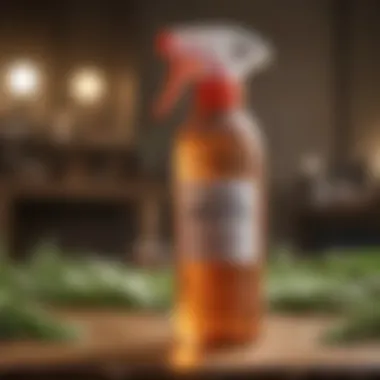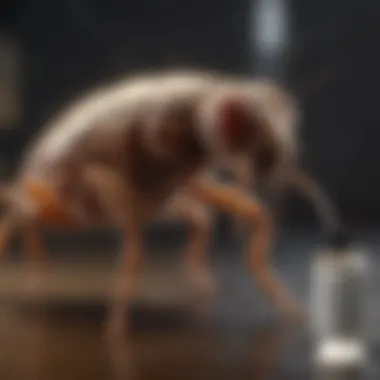Effective Strategies for Home Flea Spray Solutions


Intro
Flea infestations are a common concern for pet owners and, in many cases, an urgent issue that demands immediate action. These pests not only cause discomfort to pets but can also invade homes, leading to a persistent battle that can be difficult to overcome. Sprays designed specifically for flea elimination present one of the most accessible and effective solutions available today. This article intends to provide a thorough understanding of effective spray strategies for tackling flea problems within homes, focusing on the selection of products, their active ingredients, and best practices for use. It is essential for pet owners to not only eradicate fleas but also to maintain a safe and healthy environment for their beloved animals.
Understanding Sprays for Flea Control
Various types of sprays exist specifically formulated to combat fleas. It is imperative to distinguish between household sprays and those formulated for pets. Household sprays target fleas' habitats, while pet sprays are safe to use on the animals themselves.
Some common active ingredients found in these sprays include:
- Permethrin: An insecticide that is often used in pet products to kill fleas quickly.
- S-Methoprene: An insect growth regulator that disrupts the flea lifecycle.
- Pyrethrins: Natural insecticides derived from chrysanthemum flowers, effective against adult fleas.
Before selecting a spray, consider areas of infestation and the specific life cycle stage of the fleas.
Safety Considerations
When using sprays in your home, safety must be the priority. Protect pets and people from exposure to potentially harmful ingredients. Always:
- Read labels carefully for proper usage instructions.
- Wear gloves and use a mask when applying sprays to minimize inhalation and skin contact.
- Keep pets and children away from treated areas until they are fully dry.
Always prioritize safety; improper application can lead to adverse effects on pets and humans alike.
Best Practices for Application
- Prepare the Area: Remove pets from the treated area and vacuum thoroughly before application. This step ensures that fleas are disturbed and increases the effectiveness of the spray.
- Follow the Instructions: Adhere strictly to the product’s instructions for application techniques and recommended dosages.
- Apply in Layers: For optimal flea eradication, apply sprays in layers, focusing on areas such as carpets, bedding, and upholstery where fleas tend to breed.
- Follow Up: Repeat applications as recommended on the product label. Flea life cycles can vary, and it’s essential to ensure thorough treatment over several weeks.
Environmental Impact
It is also important to consider the environmental impact of using chemical solutions in the home. Look for eco-friendly spray options that minimize potential harm to beneficial insects and the ecosystem. Some natural alternatives, such as essential oil-based sprays, may offer a safer solution, but always verify their effectiveness against fleas.
Integration with Other Methods
Flea control is most effective when combined with other methods such as:
- Regular grooming: Bathing and cleaning pets can remove fleas and their eggs.
- Vacuuming and washing: Regularly perform these tasks to remove fleas from living spaces.
- Professional pest control: In severe infestations, engaging a professional pest service may be necessary.
Closure
Understanding how to effectively use sprays to eliminate fleas is crucial for maintaining a safe and healthy home environment for pets and humans alike. By selecting the right products, applying them properly, and respecting safety considerations, pet owners can effectively manage flea infestations and foster responsible pet ownership.
Intro to Flea Infestations
Flea infestations pose a significant threat to both pets and humans alike. Understanding this issue is crucial for effective management and eradication. Fleas thrive in warm, humid environments, making homes ideal for their proliferation. These tiny, blood-sucking parasites can lead to discomfort and health problems in pets, resulting in excessive scratching, skin infections, and potential allergies.
The financial impact is also notable; treating a flea infestation can become expensive. The role of pet ownership in this context cannot be overlooked. Responsible pet ownership includes regular veterinary visits, preventative medications, and maintaining a clean home environment. By focusing on the early detection of fleas and understanding their lifecycle, homeowners can significantly mitigate the risks. This section emphasizes the need for awareness and proactive strategies to keep fleas at bay.
Understanding Fleas: Biology and Behavior
Fleas belong to the order Siphonaptera and exhibit some unique biological traits. They can jump up to 200 times their body length, which aids dispersal in search of hosts. The most common species found in homes are the cat flea, Ctenocephalides felis, and the dog flea, Ctenocephalides canis.
Fleas have four life stages: egg, larva, pupa, and adult. An adult flea can live several months and reproduce rapidly. This means a single pair of fleas can multiply into thousands in a short time if not managed effectively. Understanding their lifecycle is essential for selecting the right extermination methods.
Fleas are not just parasites; they are capable of causing stress and discomfort, affecting the overall well-being of pets and humans. Their presence is often unnoticed until a significant infestation occurs. This makes awareness even more critical.


Identifying Signs of a Flea Problem
Recognizing a flea infestation early can save both time and money. Here are some common signs to look for:
- Frequent scratching or biting: Pets may scratch or bite at their skin more than usual, indicating irritation.
- Flea dirt: Look for tiny black specks in your pet’s fur or bedding - this is flea feces.
- Red bumps or irritation: Flea bites can cause red, irritated skin patches on both pets and humans.
- Behavior changes: Increased anxiety or restlessness in pets can signify discomfort.
- Fleas in fur: If you part your pet's fur and see moving brown or black specks, those are likely fleas.
It is essential to approach flea issues promptly. A timely response reveals commitment to pet health and home hygiene.
In summary, awareness of the signs of flea infestations can greatly enhance management efforts. Homeowners must remain vigilant and proactive to ensure a flea-free living environment.
The Role of Spray Solutions
Flea infestations can be a daunting issue for pet owners and anyone who shares their living space with animals. The role of spray solutions in combating these pests is significant. Sprays offer a direct method to target fleas in various stages of their life cycle, from eggs to adults. Unlike other treatments, sprays penetrate carpets, upholstery, and other surfaces where fleas tend to hide, ensuring a thorough eradication. They contain potent ingredients that either kill fleas on contact or disrupt their development.
The effectiveness of spray solutions lies in their ability to be both preventive and reactive. Sprays can be used as part of a comprehensive flea management system that includes routine cleaning and monitoring. This versatility allows homeowners to tackle existing infestations and protect their spaces while reducing the chances of reinfestation.
In selecting the appropriate spray solution, one must consider several elements such as safety for pets and humans, efficacy, and environmental impact. Understanding the different types of sprays and their active ingredients is crucial for making informed choices.
Types of Flea Sprays
Chemical Sprays
Chemical sprays are among the most widely used flea control solutions. They often contain synthetic insecticides that provide immediate results by killing fleas on contact. One key characteristic of chemical sprays is their potency, which effectively targets adult fleas and their eggs.
These sprays are a beneficial choice for quick knockdown of flea populations, especially in severe infestations. However, their use does raise certain concerns. Chemical ingredients can pose risks to pets and humans, making it essential to follow safety guidelines and use them judiciously.
While they are effective, the unique feature of chemical sprays is their rapid application and immediate effectiveness. However, reliance solely on chemical options may lead to resistance over time, reducing their overall efficacy. Therefore, they are best used in conjunction with other flea management strategies.
Natural Sprays
Natural sprays present a more eco-friendly alternative for addresssing flea problems. These solutions often include plant-based ingredients such as essential oils, which can repel fleas and disrupt their life cycles. The key characteristic of natural sprays is that they tend to be safer for pets and children, making them a popular choice among conscientious pet owners.
The unique feature of natural sprays is their ability to provide some degree of repellency while also being less harmful to the environment. However, natural sprays may require more frequent application to maintain effectiveness. In cases of severe infestations, they might not offer the rapid results seen with chemical alternatives.
Foggers versus Spot Treatments
Foggers and spot treatments represent two different application methods for flea sprays. Foggers, or total release aerosols, disperse insecticides in the air to treat larger areas effectively. They are beneficial when dealing with extensive infestations, ensuring comprehensive coverage in hard-to-reach places.
On the other hand, spot treatments are localized applications directly targeting areas where fleas are likely to reside, such as pet bedding or furniture. The unique feature of foggers is their ability to envelop the entire space, but they require evacuation of the area during treatment. Spot treatments allow for precision but may leave untreated areas around the home.
The choice between foggers and spot treatments should depend on the severity of the flea problem, the size of the space, and the specific areas of concern. Both methods can be effective when used correctly, and they can often be integrated into a broader flea control program.
Active Ingredients Explained
Insect Growth Regulators
Insect Growth Regulators (IGRs) play a pivotal role in flea control by preventing the development of immature fleas. They work by mimicking hormones that disrupt the normal growth cycle of fleas. The key characteristic of IGRs is their non-lethal mode of action, targeting the life cycle rather than killing adult fleas outright.
This method is particularly beneficial as it helps break the flea's reproductive cycle, reducing population growth over time. IGRs may take longer to show results compared to chemical sprays, but their systemic approach makes them valuable for long-term control.
The unique feature of IGRs is their persistence in the environment, giving ongoing protection against reinfestation.
Pyrethroids
Pyrethroids are synthetic chemicals derived from natural pyrethrins found in chrysanthemum flowers. They are effective insecticides that work by attacking the nervous system of fleas, leading to rapid knockdown effects. One key characteristic of pyrethroids is their fast action, which can result in immediate flea mortality upon contact.


They are a popular choice for many flea sprays due to their high effectiveness. However, it is important to note that they may present some risks to non-target species, including aquatic life. The unique feature of pyrethroids is their residual effectiveness, providing lasting protection even after initial application, but they should be used carefully to avoid resistance development.
Essential Oils
Essential oils have gained popularity in recent years for their natural pest control properties. Oils like peppermint, lavender, and cedarwood can act as natural repellents, helping to deter fleas from infesting treated areas. The key characteristic of essential oils is their appealing scents, offering an olfactory benefit for humans alongside pest control.
They are often included in natural sprays, highlighting their dual purpose. However, essential oils may not be as effective against mature flea populations, and their potency can vary widely depending on the specific formulation. The unique feature of essential oils is their lower toxicity for pets and humans, making them a preferred alternative for those who desire less chemically intensive solutions.
Application Best Practices
The topic of Application Best Practices is crucial in the quest to eliminate fleas from the home. Knowledge of these practices enhances the effectiveness of spray solutions while safeguarding both pets and their owners. It emphasizes preparing the environment, using the right techniques, and maintaining a consistent follow-up approach. This cares for the atmosphere in which the sprays are used, ensuring maximum efficacy against fleas.
Preparation Before Spraying
Proper preparation is the first step in the process. Begin by removing furniture, pet bedding, and any other items from the spraying area. Vacuum these areas thoroughly to remove adult fleas and their eggs. Using a vacuum can significantly reduce flea populations before applying sprays. Remember to dispose of the vacuum bag outside the home to prevent reinfestation. Additionally, ensure that pets are not present during the spraying.
After vacuuming, clean the surfaces with soapy water. This helps to eliminate leftover debris that might interrupt the spray’s effectiveness. It is also advisable to cover any plants or fish tanks to avoid contamination, as some flea sprays can be harmful to them. Ensure rooms to be treated have windows open for ventilation.
Correct Application Techniques
Following preparation, the next essential step is proper application of the flea spray. Begin by shaking the canister before use, which mixes the ingredients. Apply the spray evenly across the targeted area, ensuring to reach corners, under furniture, and along baseboards. Focus on areas where pets frequent, which are often hotspots for flea activity.
Hold the spray approximately three feet from the surface while spraying. This distance allows for even distribution. It’s advisable to apply the spray in a slow, sweeping motion rather than a rapid back-and-forth approach. This prevents uneven coverage. If using a fogger instead, ensure all necessary precautions are taken, including removing any pets and covering surfaces.
Frequency and Follow-Up Procedures
Once the initial treatment is applied, a structured follow-up is necessary. Plan for reapplication based on the product’s instructions, which usually ranges from every two to four weeks. Following the recommended frequency is vital to breaking the flea life cycle.
Conduct regular inspections of the areas treated. This includes checking pets for fleas and monitoring the home environment. Vacuum regularly to pick up any eggs that may hatch post-treatment. It is also prudent to consistently wash pet bedding in hot water. This maintains a clean and less hospitable environment for fleas.
"Effective preparation, correct application, and diligent follow-up are the holy trinity of successful flea management."
In summary, through rigorous preparation, correct application techniques, and timely follow-ups, pets and homes become less inviting to fleas. This structured approach is not just about elimination but also prevention, ensuring a long-term solution to flea infestations.
Safety Considerations
When addressing flea infestations, safety considerations are paramount. Using sprays can effectively manage these pests, but they come with risks that must be acknowledged. Understanding these safety elements is essential for ensuring both human and pet well-being during and after treatment.
Prioritizing safety means being informed about the products you use and applying them correctly. Informed decisions can aid in minimizing exposure to harmful chemicals, leading to a healthier environment. Sprays often contain various active ingredients that can be toxic if not handled properly. This underscores the importance of adhering to usage guidelines, protective measures, and preparation methods.
Effective flea management goes beyond just eradication; it encompasses the consideration of those affected by the treatments. Pets and humans alike should be protected from potential harm. Careful planning and awareness can help mitigate the risks associated with these treatments.
Protecting Pets During Treatment
Pets are often the first victims of flea infestations, but they can also be at risk during treatment. Ensuring their safety can be approached in several ways:
- Read Labels Carefully: It's crucial to check the product ingredients, making sure they are safe for the specific animals in your home. Some sprays can be hazardous to certain pets, especially birds and small mammals.
- Evacuate During Treatment: To ensure safety, it might be wise to remove pets from the treated area. Keeping them away during and shortly after application prevents potential exposure to harmful chemicals.
- Limit Contact: After application, it’s important to resist the urge to cuddle or interact with pets immediately. Wait for the spray to dry completely before allowing them back into treated spaces.
- Use Residue-Free Options: Consider using flea sprays with natural ingredients that do not leave harmful residues. These options can be safer for both pets and humans.
By taking these precautions, you can reduce the risks associated with using flea sprays in your home.
Environmental and Human Health Aspects
Flea sprays not only affect pets but can also impact human health and the environment. A holistic approach to flea-management must consider these factors.
- Chemical Exposure: Prolonged exposure to synthetic chemicals can lead to health issues in humans. Common symptoms may include headaches, respiratory issues, and skin irritations. Assessing your environment, employing good ventilation, and taking breaks can help ease exposure during treatment.
- Ecosystem Impact: Some insecticides can affect non-target species, including beneficial insects, birds, and aquatic life. Being mindful of such consequences is crucial. Opting for targeted treatments reduces broader environmental impacts.
- Waste Management: Dispose of containers and leftover product responsibly. Some chemicals can leach into the ground water if not discarded properly. Checking local guidelines for hazardous waste disposal can prevent environmental damage.


In summary, being aware of safety considerations when applying flea sprays is vital for protecting your home environment. Evaluation of the risks posed to both pets and humans fosters a responsible approach to flea control and contributes to a sustainable ecosystem. Remembering that safety measures should not be overlooked allows for effective pest management with minimal risk.
Complementary Flea Control Strategies
Addressing flea infestations requires a comprehensive approach. Relying solely on sprays may not be sufficient to achieve long-term success. Therefore, integrating sprays with other pest control methods is essential. This strategy ensures a multi-faceted attack on the problem. Combining treatments can lead to increased effectiveness and minimize the chances of fleas developing resistance. Plus, it can help target different stages of the flea life cycle, from eggs to adult fleas.
Integrating Sprays with Other Pest Control Methods
Using sprays alongside other pest control methods enhances overall effectiveness. Pesticide options such as granules or powders can be applied as additional layers of protection. It is common to use sprays to address areas where fleas are most active, such as carpets or pet bedding. Afterward, applying suitable insect growth regulators can disrupt the flea life cycle, preventing future infestations.
Incorporating bait traps can also play a role in complementing spray solutions. These traps often catch adult fleas, which can significantly reduce the flea population in your home. Places with frequent activity, like near pet sleeping areas, are ideal locations for these traps. To optimize results, it is important to follow the manufacturer’s directions for each product used.
Regular Cleaning and Maintenance Practices
Consistent cleaning practices work in tandem with sprays for effective flea control. Regular vacuuming is essential. It helps remove flea eggs, larvae, and adults from carpets and upholstery. Ensure to empty vacuum bags or containers outside promptly to prevent re-infestation.
Washing pet bedding in hot water weekly is crucial. This method kills any fleas, eggs, or larvae that might be hiding. Additionally, grooming pets regularly with flea combs removes adult fleas and larvae, serving as another line of defense.
In summary, while sprays are effective for immediate flea control, integrating them into a broader pest management strategy is essential. Regular cleaning and maintenance combined with diverse pest control methods help secure a long-term solution to flea issues.
Long-Term Preventive Measures
Effective long-term preventive measures play a crucial role in managing and ultimately eliminating flea infestations in the home. These strategies ensure that fleas do not return after initial treatments have been applied. Implementing consistent practices fosters an environment that is less conducive to flea survival and reproduction.
Regular Pet Care Routines
One of the most vital aspects of flea management involves regular pet care routines. Pets often serve as hosts for fleas; therefore, their welfare is essential in this ongoing battle against these pests. Here are some fundamental practices to consider:
- Routine Grooming: Regularly brush your pet’s fur to remove fleas and their eggs. Use a flea comb to enhance efficiency in spotting these pests. Grooming also promotes bond between pets and owners.
- Consistent Bathing: Bathe your pets with flea shampoos suitable for their specific needs. Such products effectively eliminate fleas present on their bodies, reducing the risk of infestation.
- Regular Vet Checkups: Schedule periodic veterinary visits. Your vet can recommend effective flea prevention treatments based on your pet’s health and the surrounding environment.
- Flea Preventatives: Administer topical treatments or oral medications. Flea medication such as Frontline or Bravecto can offer lasting protection, making it harder for fleas to establish themselves on your pets.
Maintaining a diligent routine not only protects your pets but also keeps your home flea-free.
Seasonal Considerations in Flea Management
Flea activity can vary with seasons. Understanding these seasonal considerations is essential for effective flea management. Here are key points to keep in mind:
- Increased Activity in Warm Months: Fleas thrive in warm, humid conditions. During the summer, their numbers can spike. Ensure that preventive measures are intensified in this period. Regular use of spray solutions becomes vital.
- Winter Awareness: Although fleas may become less active in cold weather, they do not necessarily die off. They can survive indoors. Keep indoor areas clean and monitor for fleas despite the temperature.
- Flea Life Cycle Awareness: Familiarize yourself with the flea life cycle. Fleas progress from eggs to larvae, pupae, and finally, adult fleas. Adult fleas are usually active and jump onto hosts. Maintaining control over each life stage helps in thwarting reinfestations, especially during peak seasons.
- Humidity Control: Managing indoor humidity can deter fleas from thriving. Consider using dehumidifiers in affected areas. This makes the environment less favorable for their growth, particularly in the peak flea season.
"Long-term prevention combines regular health practices for pets with environmental control methods, stabilizing efforts against flea infestations."
By enforcing these long-term preventive measures, pet owners can create a comprehensive strategy to prevent fleas effectively. Ensuring both proactive pet care and mindful seasonal adjustments will drive effective flea management. It’s about creating a holistic approach that takes into maturity all facets of the flea life cycle and behaviors, making every effort count in maintaining a flea-free household.
The End
The conclusion in this article emphasizes the critical nature of effectively managing flea infestations using sprays. This topic is not just about temporary relief but establishing a sustainable approach to pest control. Fleas are more than a nuisance; they can negatively impact the health of both pets and humans. Understanding the dynamics of fleas, the role sprays play, and complementary strategies are essential to achieving lasting results.
Summary of Key Points
The article outlines several key elements regarding the use of sprays to combat fleas:
- Types of Flea Sprays: Differentiating between chemical and natural options helps consumers make informed choices that fit their values and needs.
- Active Ingredients: Learning what goes into flea sprays allows pet owners to select products that are safe and effective.
- Application Best Practices: Knowing how to properly apply sprays maximizes their effectiveness and reduces health risks.
- Safety Considerations: Ensuring the protection of pets and humans during pest control activities is paramount.
- Complementary Flea Control Strategies: Integrating different pest management practices enhances the chances of eradication.
- Long-Term Preventive Measures: Routines and seasonal adjustments play a vital role in preventing infestations.
Leveraging these insights creates a framework for success against flea infestations, ensuring a healthier living environment for all occupants.
Encouraging Responsible Flea Management Practices
Promoting responsible flea management practices is essential for long-term control. Here are some considerations:
- Regular Monitoring: Pet owners should routinely check their pets for fleas and address any problems immediately. Early detection is crucial.
- Routine Cleaning: Keeping the home clean and vacuuming often helps remove flea eggs and larvae, making pest control efforts more effective.
- Educating Others: Sharing knowledge about flea management with fellow pet owners can create a community of informed individuals who prioritize animal welfare.
Fleas can have serious implications for household pets, making proactive management a priority for dedicated pet owners. By adopting these responsible practices, one can significantly reduce the likelihood of future infestations.







